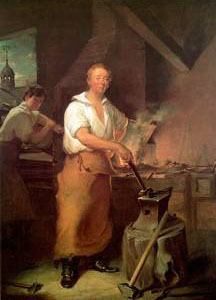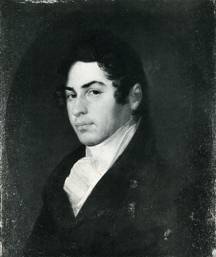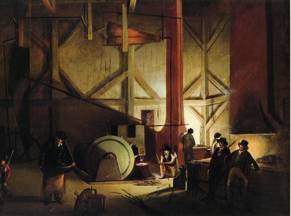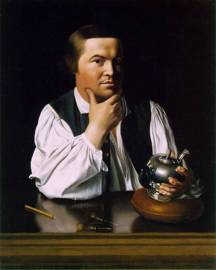|
|
Introduction
 Photo right:
Photo right: John Neagle's Pat Lyon at the Forge; 1826-1827; Oil on canvas; 93" x 68"
Museum of Fine Arts, Boston; Herman and Zoe Oliver Sherman Fund
The portrait of Pat Lyon by the artist, John Neagle, revolutionized the realm of American portraiture. It is the first known portrait depicting a laborer at work. Pat Lyon's personal story, the social climate of early America, and his pride in being a working blacksmith formed the basis of his choice to be portrayed in this way. Pat Lyon at the Forge demonstrates not only a new style of painting and subject, but also a new attitude towards the laborer and his place in society.
Early American Portraiture
American portraiture, in the decades following the revolution, documents for us a history of the burgeoning nation's attitudes and ideals. While we see continuation of the artistic styles of the Old World, there is preference for New World content. An increasingly flourishing middle class fed the American portrait market through its early colonial days in the seventeenth century through to the nineteenth, where it successfully competed with the new genres of landscape and still life, yet still managed to maintain an approximately 90% majority of all paintings commissioned. [1]
From the onset of portrait-painting in the American colonies at the end of the seventeenth century, there was already a continuation of the styles of Europe. The period, dominated by American artists such as Charles Willson Peale and Ralph Earl, is strikingly reminiscent of European artistic taste, albeit one of a preceding generation. This divergence might have stemmed from the time separating the early colonists' struggle in a primitive settlement to the relative comfort they enjoyed a generation later, after the firm establishment of the colonies. A painter, moving from Europe to the harsh life of the early colonies, would only have been able to return to painting years after his immigration, at which point, he would have been reproducing portraits from memories of his younger years, a previous European style that would have since gone out of fashion in Europe. [2] It was not until the very end of the eighteenth century that portrait-painting on both sides of the Atlantic would be revived with an entirely new style. This new style, originating in Europe, spread to America in 1793, when the highly-acclaimed master Gilbert Stuart returned after spending eighteen years in London and Dublin. With his return, he brought with him a proclivity for fluid brush strokes and elegant subjects and it became popular wherever he traveled. His influence can easily be traced in the work of the artists he encountered as he traveled around the country: New York, 1793-1795; Philadelphia, 1795-1803; Washington 1803-1805; and Boston 1805 to his death in 1828. [3]
The Artist: John Neagle
 Photo right:
Photo right: Bass Otis' John Neagle; c.1815; Oil on wood panel; 22" x 19". Pennsylvania Academy of the Fine Arts; Gift of Garrett C. Neagle
One artist, in whose work Gilbert Stuart's influence is obvious, was American-born John Neagle (1796-1865). As a boy, Neagle received a little instruction in art from a classmate named Petticolas, who later became an artist of some renown in Virginia. But after his skills quickly surpassed those of his young master, he was instructed for a short time in the drawing school of Signor Pietre Ancora, an Italian painter, and later, as an apprentice to Thomas Wilson, a coach- and ornamental-painter in Philadelphia. Many of America's first artists were either self-taught or had very little instruction, most of them beginning as house-, sign- or coach-painters. [4] It was while Neagle was apprenticed to Wilson, around the age of nineteen, that he first met Bass Otis, a Philadelphia portrait painter and engraver from whom Wilson was receiving painting lessons. Neagle customarily carried Wilson's palettes and brushes to and from Otis' studio, so Otis offered to give him a few of his own lessons. In 1815, during his short, two-month study there, Otis painted the portrait of his student depicted below, now the property of the Pennsylvania Academy of the Fine Arts. It was also during this time at the Otis studio that Neagle was fortunate to meet the prominent artist Thomas Sully. Sully began their relationship by inviting Neagle to visit his gallery and study his paintings. After a period of instruction under Sully, Neagle attempted to start a livelihood painting portraits in both Kentucky and Louisiana, but to no avail. He eventually found his way back to Philadelphia to start what would become a very successful painting career. It was in 1826 when Neagle received the commission of his lifetime, the portrait of Patrick Lyon.
The Blacksmith: Patrick Lyon
Patrick Lyon (1779-1829) was a Philadelphia blacksmith of some reputation and wealth. Born in London, he moved to America to establish a smithing business there. In addition to blacksmithing, he also built fire engines and was renowned for his locksmithing. Early in his career, the Bank of Pennsylvania commissioned him to make the locks for their vault and in 1798, when it was robbed of over $160,000, suspicion immediately fell on him. 1798 was the same year that yellow fever plagued the region and therefore, Lyon was away from Philadelphia, in Delaware, with his assistant. Upon his return and learning of the accusations against him, he went to prove his innocence to the bank's president, cashier and alderman. Despite an undeniable alibi for his whereabouts, they insisted that he was at the least an accomplice and had him imprisoned under a large bail. Unable to meet the bail, Lyon remained in the Walnut Street Gaol for three months. It was later discovered that the robbery had actually been perpetrated by the bank's porter and a carpenter, who returned almost all of the stolen money, the porter having died of yellow fever shortly after the robbery. Upon his release, Lyon sued the bank's directors and was eventually granted a sum of $9,000 for the damages to his smithing business and reputation. It is unclear whether this sum was the foundation of his fortune, but he was able to recover fully from the injury to his business and went on to amass considerable wealth.
The Portrait: Pat Lyon at the Forge
Pat Lyon at the Forge, or as it is formally known, Full length Portrait of Mr. Patrick Lyon representing him as engaged at his anvil, is a large oil on canvas of dimensions 93" by 68". It was painted between the years of 1826 and 1827 and is owned by the Museum of Fine Arts in Boston (Herman and Zoe Oliver Sherman Fund). There is one enlarged (69" by 95") replica from 1829 by Neagle with some changes and additions, owned by the Pennsylvania Academy of the Fine Arts. The magnitude of this portrait lies in the fact that it depicts Pat Lyon dressed not as a gentleman, as was almost exclusively customary, but as a laborer, in leather apron, no jacket, his sleeves rolled up, at work at his anvil. In the background, an assistant stokes the forge and through the window peeks a small cupola. Although the cupola is usually assumed to belong to the Walnut Street Gaol, where Lyon was imprisoned, it is more likely Carpenters' Hall, where the Bank of Pennsylvania was housed at the time of its robbery. [5] Lyon's blacksmithing tools are carefully painted as exact as Neagle could make them; at the time of the painting, he confided in his friend John Sartain, an engraver, that his anxiety had made him meticulously reproduce all of the smith's tools, going so far as to measure them. [6] These tools, so faithfully rendered, were the source of great praise for Neagle from contemporary critics. In a June 1827 issue of The Saturday Evening Post, the editor Chandler related that they were reproduced "with a fidelity that would have done credit to the superior acquaintance in such implements, of Otis." [7]
[This comparison stems from an early piece of Otis', entitled Interior of a Smithy. The piece, completed around 1815, is supposedly painted from Otis' childhood memories of a foundry in New England, where he was apprenticed. Otis' influence most likely did appear in the Neagle painting, but the Otis work differs profoundly, in that it was a genre composition, not a portrait.] Neagle's piece received other, even greater, praise during his lifetime. A Boston artist, known only under the initials D.F., declared that "the novelty of the subject, and felicity of its execution" made it "the most unique portrait that had appeared before the public." [8] Today it is remembered as one of the period's greatest examples of its particular genre.
Art in the New World: the Glorified Laborer
 Photo left:
Photo left: Bass Otis' Interior of a Smithy; c. 1815; Oil on canvas; 50 1/2" x 80 1/2"
Pennsylvania Academy of the Arts; Gift of the artist
A painting of such content had never before been seen in either the Old or the New World. How was it possible for such a young artist to paint such an extraordinary subject? The answer to this question lies in the new nation's perception of itself and its newfound ideals. The young country had just fought a war both for equality, where laborers were considered equal to gentlemen, and in support of a fair government with an egalitarian judicial system. Lyon's story embodied both of these principles. Not only did he represent the "American" ideal of starting from nothing and making something of oneself, but he also vindicated the new American political system. Judge Yates, the judge assigned to Lyon's trial, stated in his last charge to the jury, "...the tradesman who depends upon his labor for his existence, is to be regarded as much as any other member of the community, Wealth and respectability of character should not weigh as a feather in the scale, when another man's rights are violated. It is unquestionably time, that in our country at least, we stand up on the rights of man, neither wealth nor office create an unequal standing, or give to any man a superiority over his fellow citizens." [9]
This novel outlook on laborers was also in large part due to the machinations of Benjamin Franklin. He advertised for artisans to immigrate to America from Europe to "practice profitable mechanic Arts, without incurring Disgrace on that Account, but on the contrary, acquiring Respect by such Abilities." [10] Franklin supported the Protestant work ethic, whose reward for hard work was material gain. In his advertisements, he appealed to the struggling masses of overpopulated Europe:
...there is a continued Demand for more Artisans of all necessary and useful kinds.... Tolerably good Workmen in any of those mechanic Arts are sure to find Employ[ment], and to be well paid for their Work, there being no Restraints preventing Strangers from exercising any Art understand, nor any Permission necessary. If they are poor, they begin first as Servants or Journeymen; and if they are sober, industrious, and frugal, they soon become Masters, establish themselves in Business, marry, raise Families, and become respectable Citizens. [11]
This work ethic permeated American culture and eventually the art that depicted it. It was the combination of manual labor, and the ethics of morality, dignity and industry that would help create a truly American style of art. [12]
The same analysis of the social atmosphere surrounding and influencing the portrait of Pat Lyon can also be applied to John Singleton Copley's Paul Revere, painted between 1768-1770 and housed at the Museum of Fine Arts in Boston. Here, too, we see the smith (whitesmith, in Revere's case) depicted studying his work, without a gentleman's coat. Although not taken nearly to the extremity of Neagle's piece (Revere is not laboring in the least.), this painting, through its depiction of Revere without jacket and holding a piece of his own handiwork, also demonstrates the newfound ideals of the colonies, making it a perfect visual antecedent to Pat Lyon at the Forge.
 Photo left:
Photo left: John Singleton Copley's Paul Revere; 1768-1770; Oil on canvas; 28 1/2" x 35". Museum of Fine Arts, Boston.
The third reason behind this steadily increasing divergence from European art of the same period lies in the type of citizenry that comprised early American society. These were a practical, materialistic people, made up of merchants and farmers. The type of art being painted concurrently in Europe was becoming increasingly romanticized, reminiscent of the artists of Antiquity, the Renaissance and the Baroque (Titian, Correggio, Raphael) with scenes of nude classical goddesses and Biblical heroes. While some American artists attempted to institute the popularity of this style in America (namely John Trumbull, John Vanderlyn and Washington Allston), Americans preferred to give their support to artists who could paint scenes of the country and life with which they were familiar. [13]
The fact that the painting depicts a laborer at work was singular, remarkable and unprecedented. Even Pat Lyon recognized the change in society's perception of the laborer's status. When commissioning his portrait, he entreated Neagle:
I wish you, sir, to paint me at full length, the size of life, representing me at the smithery, with my bellows blower, hammers, and all the etceteras of the shop around me.... I wish you to understand clearly, Mr. Neagle, that I do not desire to be represented in the picture as a gentleman-to which character I have no pretension. I want you to paint me at work at my anvil, with my sleeves rolled up and a leather apron on.
Despite his own membership in the gentlemanly class, Lyon realized that the laborer had become both a token of moral uprightness and a symbol of the ideals of the new nation; his depiction in Neagle's painting as a blacksmith would forever immortalize him as the victim of an unjust persecution from those "gentlemen" with whom he so earnestly avoided association. The contemporary editor, Chandler, described the portrayal of Lyon as having "that peculiar right forward look of self complacency, that denotes all well within, and that generous glow of countenance that tells of self dependence, and consciousness of right." [14] He was not the only one to note this facet of the painting; it was the quite obvious and deliberate intent of the artist and his subject.
American society's increasingly positive opinion of the laborer, the blacksmith in particular, was further evident in the numerous honors personally accorded to Lyon during and after his life. The simple fact that a mere blacksmith would be so highly esteemed was in itself an extraordinary circumstance that would later be accompanied by additional recognition. On March 7, 1832, a parade of black- and whitesmiths used the background of the portrait of Pat Lyon as the decoration on one of their banners. Emblazoned across the banner were also the words "The art of man is great indeed/But none the Blacksmith can exceed." [15] A decade later, James Rees, a Philadelphia playwright, wrote a "domestic drama" about Lyon, entitled "Pat Lyon, the Locksmith of Philadelphia." Performed on May 7, 1842 at the Arch Street Theatre in Philadelphia, the play was "accurately composed from published and verbal authority" with even the scenery meticulously replicated from Neagle's painting by the set designer, John Wiser. [16] After Lyon's death, his biography was written in Henry Simpson's The Lives of Eminent Philadelphians, published in 1849. Here Lyon's story was printed alongside the biographies of the country's most revered citizens, comprised primarily of scientists, doctors, merchants, lawyers and soldiers. Including Lyon among the ranks of such highly esteemed men can be attributed to the respect he had garnered through his trial and imprisonment and the characteristically American regard for all men, regardless of social standing. Simpson concluded the entry by explaining that Lyon was "respected for his honesty and fair-dealing, and a bright example to those whose bad luck may sometimes be in the ascendant; but who nevertheless, if they are honest, will be sure to conquer." [17]
Conclusion
In 1798, after losing both his wife and his daughter to yellow fever, Lyon feared for his own death and wrote his last will and testament, with the following epitaph:
My sledge and hammer's both declin'd,
My bellows too have lost their wind;
My fire's extinct; my forge decay'd,
And in the dust my vice is laid;
My coal is spent, my iron's gone,
My nails are drove, my work is done.
[18]
On the contrary, Lyon lived another thirty years, passing away in 1829. His story lives on today, however, through the artistic genius of John Neagle. Pat Lyon at the Forge serves as a depiction of the origin of America and the people who comprised it. Though not formally trained, Neagle was one of a great community of truly American artists who, by painting their way through the trials of the nation's early years, have handed down to us not only the stories of America's ancestors, but an artistic style all their own.
Cited and Recommended Reading
- Craven, Wayne. "Bass Otis: A Critical Commentary" pp. 24-30 in Bass Otis: Painter, Portraitist and Engraver. Wilmington: Historical Society of Delaware, 1976.
- Craven, Wayne. Colonial American Portraiture. Cambridge University Press, 1986.
- Dabakis, Melissa. Visualizing Labor in American Sculpture. Cambridge University Press, 1999.
- Davis, Gainor B. "Bass Otis: Painter, Portraitist, and Engraver" pp. 11-23 in Bass Otis: Painter, Portraitist and Engraver. Wilmington: Historical Society of Delaware, 1976.
- Dresser, Louise. The Background of Colonial American Portraiture. Worcester, MA: American Antiquarian Society, 1966.
- Fielding, Mantle. "John Neagle" pp. 5-15 in Catalogue of an Exhibition of Portraits by John Neagle. Philadelphia: Pennsylvania Academy of Fine Arts, 1925.
- Lee, Cuthbert. Early American Portrait Painters. Yale University Press, 1929.
- Sherman, Frederic Fairchild. Early American Painting. New York: Century Co., 1932.
- Torchia, Robert W. John Neagle: Philadelphia Portrait Painter. Philadelphia: Historical Society of Pennsylvania, 1989.
Notes
- [back] Craven, Bass
Otis: Painter, Portraitist and Engraver, 25
- [back] Dresser 31
- [back] Craven, Bass
Otis: Painter, Portraitist and Engraver, 25-26
- [back] Sherman xii
- [back] Fielding 10
- [back] Fielding 10
- [back] Saturday
Evening Post,
unidentified issue of June 1827 in Scrapbook I, HSP. Cited from Torchia
84.
- [back] D.F., Evening
Gazette,
31 May 1828. Neagle identified the author only as a “Boston artist.” Cited
from Torchia 84.
- [back] The
Trial 176. Cited in
Torchia 81.
- [back] Craven, Colonial
American Portraiture, 334-35.
- [back] Craven, Colonial
American Portraiture, 334-35.
- [back] Dabakis 7
- [back] Craven, Bass
Otis: Painter, Portraitist and Engraver, 25-26
- [back] Saturday
Evening Post,
unidentified issue of June 1827 in Scrapbook I, HSP. Cited from Torchia
83.
- [back] Torchia 89
- [back] HSP Scrapbook II. Probably
written by Neagle’s friend, Charles Durang as part of his Sunday
Dispatch series on the history of the American stage. Cited from Torchia
89.
- [back] Henry Simpson, The
Lives of Eminent Philadelphians [Philadelphia, William Brotherhead,
1859], 678. Cited in Torchia 89.
- [back] Lyon 35. Cited in Torchia
89-9
Brigitte Weinsteiger
Penn State University Center for Medieval Studies
 Download this article as a PDF file Part 1 | Part 2

|
 Photo right: John Neagle's Pat Lyon at the Forge; 1826-1827; Oil on canvas; 93" x 68"
Museum of Fine Arts, Boston; Herman and Zoe Oliver Sherman Fund
Photo right: John Neagle's Pat Lyon at the Forge; 1826-1827; Oil on canvas; 93" x 68"
Museum of Fine Arts, Boston; Herman and Zoe Oliver Sherman Fund
 Photo right: Bass Otis' John Neagle; c.1815; Oil on wood panel; 22" x 19". Pennsylvania Academy of the Fine Arts; Gift of Garrett C. Neagle
Photo right: Bass Otis' John Neagle; c.1815; Oil on wood panel; 22" x 19". Pennsylvania Academy of the Fine Arts; Gift of Garrett C. Neagle Photo left: Bass Otis' Interior of a Smithy; c. 1815; Oil on canvas; 50 1/2" x 80 1/2"
Pennsylvania Academy of the Arts; Gift of the artist
Photo left: Bass Otis' Interior of a Smithy; c. 1815; Oil on canvas; 50 1/2" x 80 1/2"
Pennsylvania Academy of the Arts; Gift of the artist
 Photo left: John Singleton Copley's Paul Revere; 1768-1770; Oil on canvas; 28 1/2" x 35". Museum of Fine Arts, Boston.
Photo left: John Singleton Copley's Paul Revere; 1768-1770; Oil on canvas; 28 1/2" x 35". Museum of Fine Arts, Boston.

